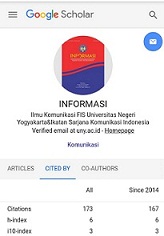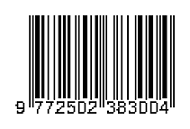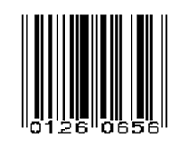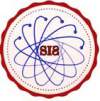"Merapi Volcano Imaginary" an alternative multimedia learning geography in the south region of Merapi volcanism
DOI:
https://doi.org/10.21831/informasi.v52i2.56377Keywords:
interactive multimedia learning, Merapi, vulcanism, geography, android baseAbstract
References
Arsyad, A . (2010) Media Pembelajaran. PT Raja Grafindo Persada
Bednarz, R.S, and Petersen. J.F. (1994): A decade of Reform in Geography Education: Inventory and Prospect. Indiana, Pa.: National Council for Geographic Education
Borg,W.R & Gall, M.D. (1983). Educational Research: An Introduction. London: Longman. Inc.
Bosco, A. M., & Ferns, S. (2014). Embedding of authentic assessment in work-integrated learning curriculum. Asia-Pacific Journal of Cooperative Education, 15(4), 281–290.
Branch. M. R. (2009). Instructional design: the ADDIE approach. New York: Springer.
Dale, E. (1967). The historical setting of programmed instruction. In P. C. Lange (Ed.), Programmed instruction: Sixty-sixth yearbook of the National Society for the Study of Education, Part 2 (pp. 28–54). Chicago: University of Chicago Press
Flynn, K. C. (2018) "Improving spatial thinking through experiential-based learning across international higher education settings," International Journal of Geospatial and Environmental Research: Vol. 5: No. 3, Article 4. Retrieved from: https://dc.uwm.edu/ijger/vol5/iss3/4
Grzyb, T, and Dolinski, D. (2021). The Field Study in Social Psychology: How to Conduct Research Outside of a Laboratory Setting?. London: Routledge. DOI: https://doi.org/10.4324/9781003092995
Haggett, Peter. (2001). Geography: a global synthesis. England: Pearson Education,
Hamalik, Oemar, (1989). Media Pendidikan. Bandung: UPI.
Idris, Husni. (2008). Pengembangan Multimedia Pembelajaran Berbantuan Komputer. (online). Tersedia: http:/Jurnaliqro.files.wordpress.com /2008/08/05
Johnson, E.B. (2001). Contextual teaching and learning: What It Is and Why It's Here to Say. Corwin Publisher. ISBN-13:978-0761978657.
Khotimah, N., Sumunar, D.R.S., Purwantara, S., Prabintoro, N.S., Ibrahim, M.H., Nayan, N. (2022). The role of social media as a communication facility for hydrometeorological disasters in shallot farming activities. Informasi Vol. 52, No. 1. pp. 47-62 doi: http://doi.org/10.21831/informasi.v52i1.50115. 47-62
Lambert, D. & Morgan, J. (2010). Teaching geography (11–18): A conceptual approach. New York: Open University Press
Munandar, A. (2017), Perbandingan Kegiatan Fieldstudy di Program Study/Jurusan Pendidikan Geografi (Study di UNJ, UPI, UNESA, UNY), Jakarta: Univesitas Negeri Jakarta
Munandar, A., Maryani, E., Rohmat, D., & Ruhimat, M. (2020). Establishing the Professionalism of Geography Teacher through Authentic Assessment Field Study. International Journal of Instruction, 13(2), 797-818. https://doi.org/10.29333/iji.2020.13254a
Nursa'ban, M. (2013). Field study: Pembelajaran inovatif materi-materi fisiografis Mata pelajaran geografi SMA. Prosiding Pertemuan Ilmiah Tahunan (PIT) XVI Ikatan Geografi Indonesia. Banjarmasin, 2-3 November 2013. ISBN: 978-602-1322-00-0.
Riyanto, Y. (2009). Paradigma Baru Pembelajaran. Jakarta : Raja Grafika
Rusman. (2011). Model – Model Pembelajaran. Jakarta: PT. Raja grafindo Persada.
Sanjaya, W. (2010). Strategi Pembelajaran Berorientasi Standar Proses. Pendidikan. Jakarta: Kencana
Sardiman, A.M. (2009). Interaksi dan Motivasi Belajar Mengajar. Jakarta. PT. Rajawali Pers.
Seperti Indonesia, Negara-Negara G20 Dorong Pembelajaran Tatap Muka: The Ministry of Education and Culture, (2022, Juli 08). Accessed https://www.kemdikbud.go.id/main/blog/2022/07/seperti-indonesia-negaranegara-g20-dorong-pembelajaran-tatap-muka
Sigit, dkk. (2008). Pengembangan Pembelajaran dengan Menggunakan Multimedia Interaktif Untuk Pembelajaran yang Berkualitas. Karya Tulis Ilmiah. Universitas Negeri Semarang.
Sofyan, A. F. (2008). Digital Multimedia: Animasi, Sound, Editing, dan Vidio Animasi.
Sugiyanto. (2010). Model-model Pembelajaran Inovatif. Surakarta: Yuma Pressindo
Sutopo, A. H. (2003). Multimedia Interaktif Flash. PT Graha Ilmu. Yogyakarta.
Taylor, P.J., and Keefe, P, (2021) a Praise of Geography as a field of study for the climate emergency. Royal Geographical Society. Vol. 187 issue 4 P: 394-401. DOI: 10.1111/geoj.12404
Downloads
Published
How to Cite
Issue
Section
Citation Check
License
Authors who publish with this journal agree to the following terms:
- Authors retain copyright and grant the journal right of first publication with the work simultaneously licensed under a Creative Commons Attribution License that allows others to share the work with an acknowledgement of the work's authorship and initial publication in this journal.
- Authors are able to enter into separate, additional contractual arrangements for the non-exclusive distribution of the journal's published version of the work (e.g., post it to an institutional repository or publish it in a book), with an acknowledgement of its initial publication in this journal.
- Authors are permitted and encouraged to post their work online (e.g., in institutional repositories or on their website) prior to and during the submission process, as it can lead to productive exchanges, as well as earlier and greater citation of published work (See The Effect of Open Access).























